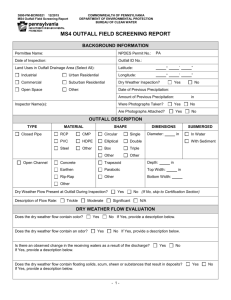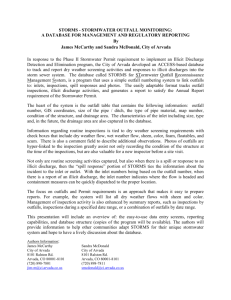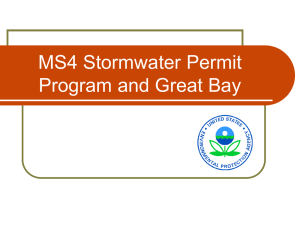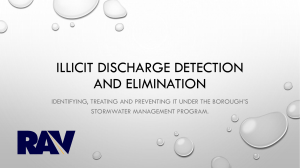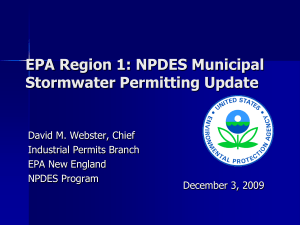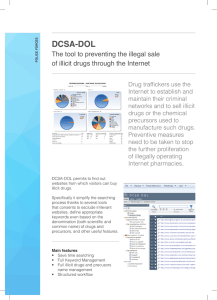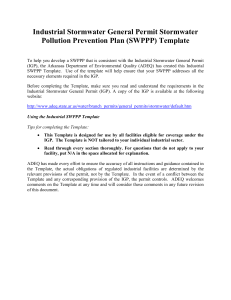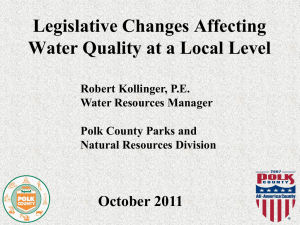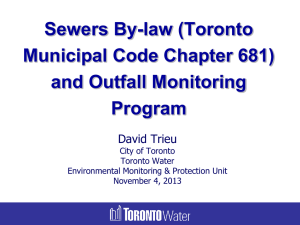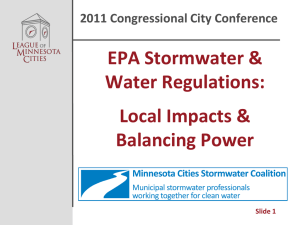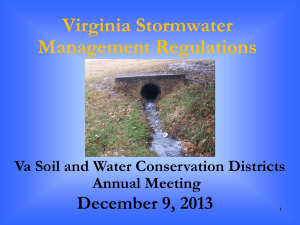MS4_IDD&E_Checklist
advertisement
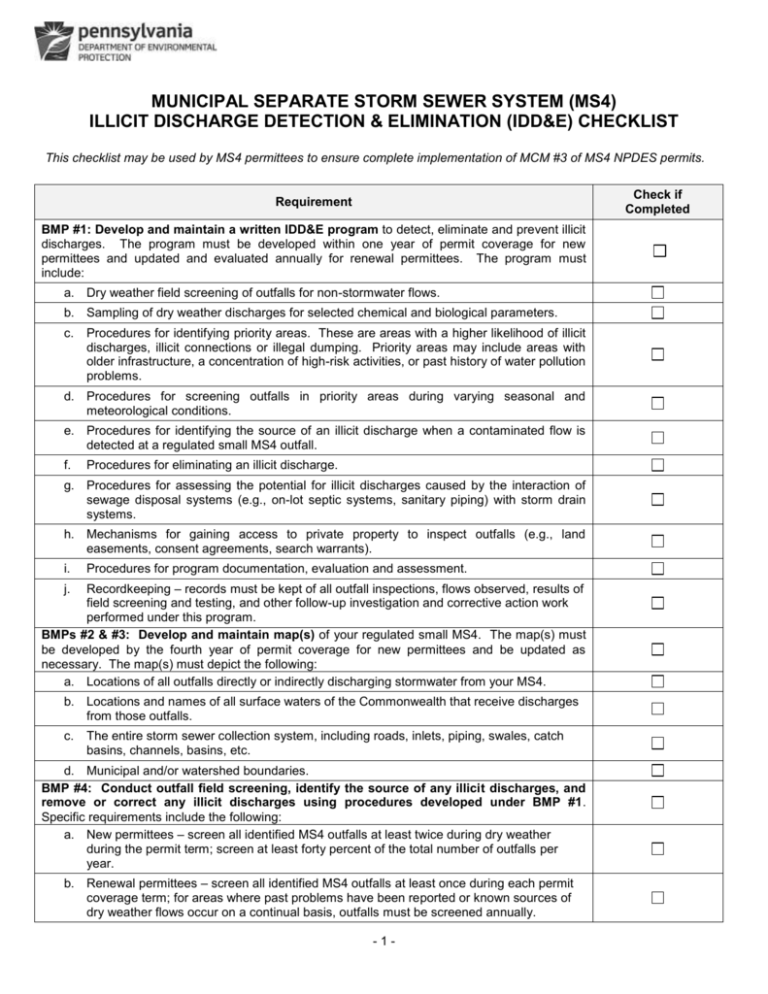
MUNICIPAL SEPARATE STORM SEWER SYSTEM (MS4) ILLICIT DISCHARGE DETECTION & ELIMINATION (IDD&E) CHECKLIST This checklist may be used by MS4 permittees to ensure complete implementation of MCM #3 of MS4 NPDES permits. Check if Completed Requirement BMP #1: Develop and maintain a written IDD&E program to detect, eliminate and prevent illicit discharges. The program must be developed within one year of permit coverage for new permittees and updated and evaluated annually for renewal permittees. The program must include: a. Dry weather field screening of outfalls for non-stormwater flows. b. Sampling of dry weather discharges for selected chemical and biological parameters. c. Procedures for identifying priority areas. These are areas with a higher likelihood of illicit discharges, illicit connections or illegal dumping. Priority areas may include areas with older infrastructure, a concentration of high-risk activities, or past history of water pollution problems. d. Procedures for screening outfalls in priority areas during varying seasonal and meteorological conditions. e. Procedures for identifying the source of an illicit discharge when a contaminated flow is detected at a regulated small MS4 outfall. f. Procedures for eliminating an illicit discharge. g. Procedures for assessing the potential for illicit discharges caused by the interaction of sewage disposal systems (e.g., on-lot septic systems, sanitary piping) with storm drain systems. h. Mechanisms for gaining access to private property to inspect outfalls (e.g., land easements, consent agreements, search warrants). i. Procedures for program documentation, evaluation and assessment. Recordkeeping – records must be kept of all outfall inspections, flows observed, results of field screening and testing, and other follow-up investigation and corrective action work performed under this program. BMPs #2 & #3: Develop and maintain map(s) of your regulated small MS4. The map(s) must be developed by the fourth year of permit coverage for new permittees and be updated as necessary. The map(s) must depict the following: a. Locations of all outfalls directly or indirectly discharging stormwater from your MS4. j. b. Locations and names of all surface waters of the Commonwealth that receive discharges from those outfalls. c. The entire storm sewer collection system, including roads, inlets, piping, swales, catch basins, channels, basins, etc. d. Municipal and/or watershed boundaries. BMP #4: Conduct outfall field screening, identify the source of any illicit discharges, and remove or correct any illicit discharges using procedures developed under BMP #1. Specific requirements include the following: a. New permittees – screen all identified MS4 outfalls at least twice during dry weather during the permit term; screen at least forty percent of the total number of outfalls per year. b. Renewal permittees – screen all identified MS4 outfalls at least once during each permit coverage term; for areas where past problems have been reported or known sources of dry weather flows occur on a continual basis, outfalls must be screened annually. -1- MS4 IDD&E Checklist Check if Completed Requirement c. If screening reveals dry weather flow, the discharge from the outfall and the area around the outfall must be inspected visually for color, turbidity, sheen, floating or submerged solids; for adverse effects on plants or animals in proximity to the outfall; and for odor. If the outfall produces any odor, or if the visual inspection shows any indication that the discharge may contain pollutants, then samples of the discharge must be collected for field and/or lab testing of selected chemical and biological parameters as part of a process to determine if the dry weather flow is illicit. d. Prioritize outfall screenings according to the perceived chance of illicit discharges within the outfall’s contributing drainage area. e. Inspections must be recorded on the Outfall Reconnaissance Inventory/Sample Collection field sheet. f. Adequate written documentation must be maintained to justify a determination that an outfall flow is not illicit. If an outfall flow is illicit, the actions taken to identify and eliminate the illicit flow must be documented. g. The results of outfall inspections and actions taken to remove or correct illicit discharges must be summarized in periodic reports. BMP #5: Enact a stormwater management ordinance to implement and enforce a stormwater management program that includes prohibition of non-stormwater discharges to the regulated small MS4. a. New permittees – within the first year of coverage under the permit, new permittees must enact and implement an ordinance from an Act 167 Plan approved by the Department in 2005 or later, the MS4 Stormwater Management Ordinance, or an ordinance that satisfies all applicable requirements in a completed and signed MS4 Stormwater Management Ordinance Checklist. b. New permittees – submit a letter signed by a municipal official, municipal engineer, or the municipal solicitor as an attachment to your first year report certifying the enactment of an ordinance that meets all applicable requirements of this permit. c. Renewal permittees – continue to maintain, update, implement, and enforce a Stormwater Management Ordinance that satisfies all applicable requirements. BMP #6: Provide educational outreach to public employees, business owners and employees, property owners, the general public and elected officials (i.e., target audiences) about the program to detect and eliminate illicit discharges. a. During each year of permit coverage, appropriate educational information concerning illicit discharges shall be distributed to the target audiences using methods outlined under MCM #1 of the MS4 NPDES permit. b. Establish and promote a stormwater pollution reporting mechanism (e.g., a complaint line with message recording) by the end of the first year of permit coverage for the public to use to notify you of illicit discharges, illegal dumping or outfall pollution. c. Respond to all complaints in a timely and appropriate manner. Document all responses, include the action taken, the time required to take the action, whether the complaint was resolved successfully. -2-
